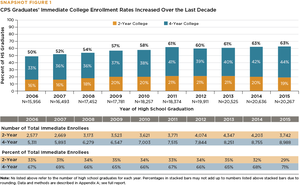1. How has enrollment in two-year colleges and in four-year colleges changed over the last decade?
2. To what extent do the patterns of enrollment differ by racial/ethnic, socioeconomic, or academic background characteristics of students? To what extent do patterns vary by type of high school attended?
3. To what extent do enrollees at two-year colleges have academic qualifications that are different from enrollees at four-year colleges and from students who do not enroll in college?
As a college degree is increasingly seen as an essential step in a student’s path to a successful future, this new report from the UChicago Consortium and the To&Through Project provides a descriptive examination of two- and four-year college enrollment patterns among Chicago Public Schools (CPS) graduates over the last 10 years. The study finds CPS graduates' immediate college enrollment rates increased over the last decade, with 63 percent of 2015 graduates enrolling in either a two- or four-year college immediately after high school, compared to 50 percent of graduates in 2006. However, many students delay enrollment. Nineteen percent of 2009 CPS high school graduates delayed enrollment, with 40 percent of those who delayed eventually enrolling in two-year colleges and 12 percent of delayed enrollees eventually enrolling in a four-year college. Further, immediate enrollment only tells part of the story. The study finds that 26 percent of CPS graduates who first enrolled in a four-year college transferred to a two-year college within four years of high school graduation, suggesting a need to better understand the factors driving this trend. Sixteen percent of immediate two-year college enrollees transferred to a four-year college within four years.
The majority of 2009 CPS graduates who immediately enrolled in college enrolled in four-year colleges. The rate of two-year enrollment increased by 3 percentage points between 2006 and 2015, but the trend in two-year enrollment has recently diverged from the four-year enrollment trend. While rates of four-year enrollment increased since 2013, the rates of two-year enrollment decreased slightly. This means two-year enrollment now accounts for a smaller share of overall college enrollment than it has in the past. The growth in two-year enrollment was mainly at the City Colleges of Chicago.
CPS graduates enrolled directly in two-year colleges at lower rates than seen in urban districts and nationally. In 2015, CPS graduates' rate of enrollment in four-year colleges was equal to the national rate at 44 percent, and higher than some urban districts, including New York and Los Angeles, which were 38 percent and 24 percent respectively. Nineteen percent of CPS graduates enrolled in two-year colleges, compared to 25 percent of graduates nationally.
In looking at enrollment rates by student subgroup, the report finds Latino graduates had the lowest rates of overall college enrollment and the highest share of two-year college enrollment. Four-year college enrollment rates differed more by poverty level than two-year college enrollment rates. In 2015, 55 percent of graduates from high median income families enrolled in a four-year college, while 39 percent of graduates from low median income families enrolled in a four-year college. Graduates with lower grades and lower ACT scores were less likely to enroll in college and more likely to enroll in a two-year college.
The report found variability in the academic characteristics of students who enroll in both two- and four-year colleges. Half of two-year enrollees had at least a 2.5 GPA, and about 40 percent of two-year enrollees had at least an 18 on the ACT. Nationally, the vast majority of four-year enrollees (91 percent) had at least a 2.5 GPA. There was considerable variability in students' GPA by institution attended, and students enrolled in the same colleges had very different ACT scores. The differences in GPA and ACT profiles of CPS graduates are greater across four-year institutions than across two-year institutions. Taken together, these findings suggest a need to better understand the myriad factors that inform students' college choices, as many students in the sample did not enroll in college, despite being qualified, while others did enroll despite relatively low levels of academic preparation.





